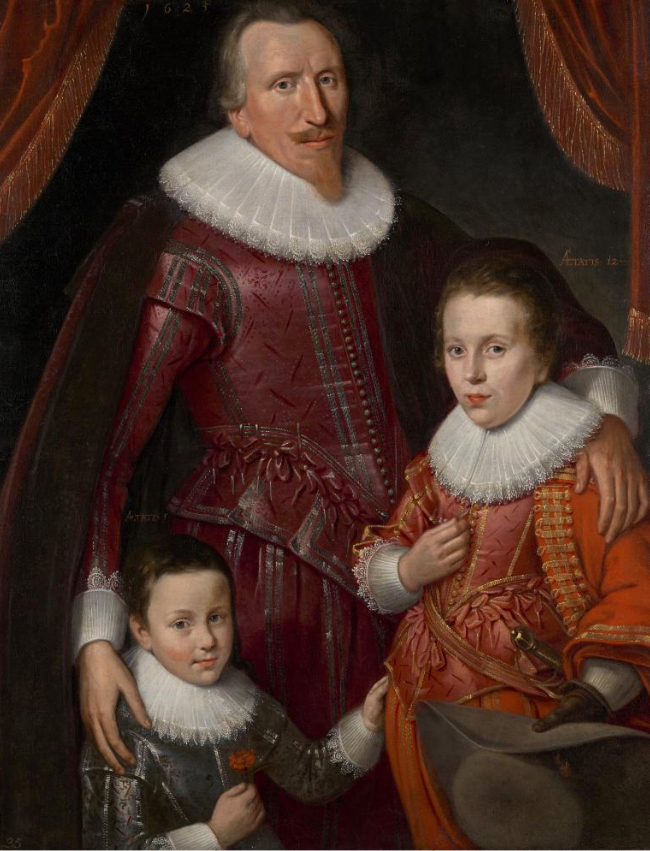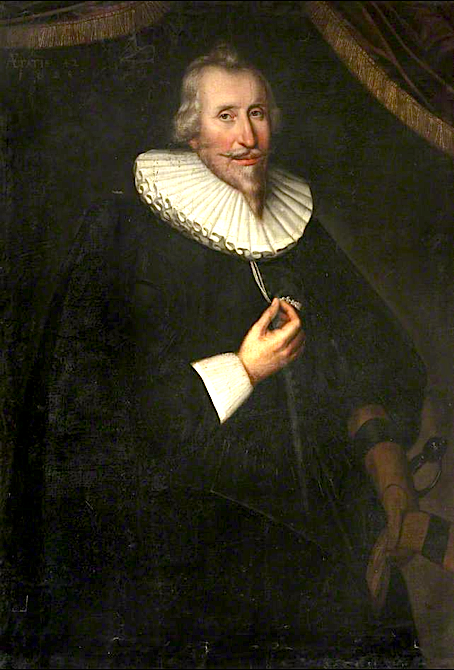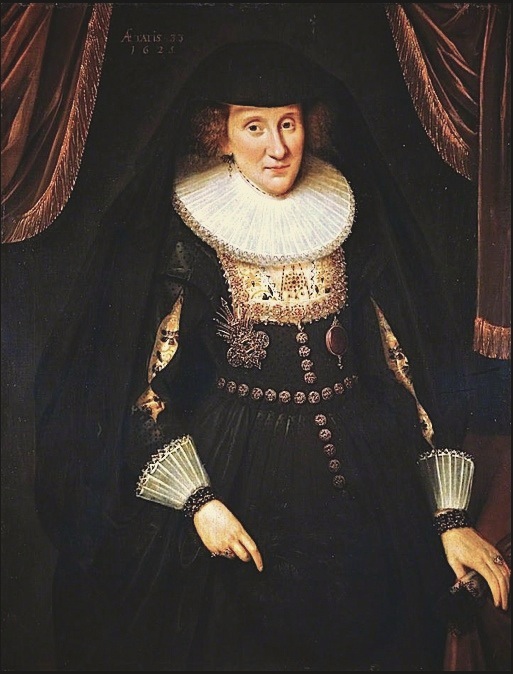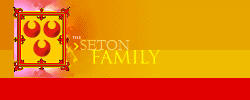|

George Seton,
3rd Earl of Winton
and 10th Lord Seton
He was born
in December 1584, and raised as the second son of the illustrious House of
Seton. He was educated
by the Jesuits in France, as well as in Rome, which aroused suspicions among his
Presbyterian countrymen of his being ‘popishly affected’. With his uncle
being Chancellor of the Realm and Earl of Dunfermline, his education was
well-attended to and he was reared with much of the same tutelage as Prince
Charles (later King Charles I) had been under the Chancellor Seton's hand.
George officially became Earl of Winton in 1607 when his elder brother Robert
was confined on grounds of insanity and resigned the peerage.
This portrait
presented is the finest surviving example of Adam de
Colone’s work, and now in the care of The National Portrait
Gallery. The portrait by Adam de Colone, oil on canvas,
114.3 by 83.8 cm, depicts George Seton (1584-1650), 3rd Earl
of Winton and his two sons, George, Master of Seton
(1613-1648) and Alexander Seton, 1st Viscount of Kingston
(1621-1691). The inscription records that they are aged 40,
12 and 8, which would date the portrait to c. 1625. He had
been a member of the Scottish Privy Council since he
inherited the title, and at the time that the portrait was
painted he was the Council’s President.
Robert, 2nd Earl
of Winton was declared unbalanced and went mad on his
wedding night, emptying a chamber pot down his bride's
cleavage. The pressures of his duties and offices and Estate
detracting from his interests and pursuits, was accordingly
for a time kept shut away at Seton, where by agreement he
diligently worked away on his building projects, and the
management of the family estates, until his death.
Because of
Robert's incapacity he was prevailed upon to resign the
Earldom in favour of his younger brother George, on 26 June
1606, although this was not put into effect until 12 May
1607. It has been said that his brother George's motivation
for the restoring and rebuilding Winton House, was to ensure
that his older brother Robert would be honorably and
suitably cared for during the remainder of his life, after
presenting him with the family honours and estates at such
an opportune age, and
stage in his life and career. Had his elder brother Robert had issue,
George would have doubtless
founded an illustrious branch of the family irregardless, but the titles passed to
him as a
result of Robert's lack of heir.
Nevertheless, George continued the developments that his brother and
father had begun at the Palace of Seton, and at Port Seton, as well as through out the many
estates under his control in both East and West Lothian.
In 1620, he
rebuilt the house of Winton from the foundation, which had
been burned by the English of old, and restored the park,
orchard, and gardens around it.
The house was redesigned and built by
William Wallace who was appointed King’s Master-Mason for
Scotland in 1617. This “ peculiar and beautiful structure, “
as Burton calls it, was prepared accordingly for the Royal
visit, with it's magnificent Hall, and it's adjoining
apartment, called the “King’s Chamber,” was occupied
by Charles I when he came to Scotland to be crowned in 1633. In 1630, Lord
Winton built two quarters of the house Seton, beginning at
Wallace’s tower, which was all burned by the English, and
continued as far as Jacob’s tower.
Because the Palace
of Seton had been burned
by the English during the wars, and better times (as he thought) were now at
hand, upon the rebuilding he caused to be carved on a fine stone tablet “upon the frontispiece of
his new building” a crown supported by a thistle between two roses, being the
cognizance of the two kingdoms: the emblem enigmatedly signifying the union of
Scotland and England.
Under it he caused to be inscribed in deep letters of gold
this Latin verse:
“Unio Nune Stoque Cadoque Tuis.” Mylne makes a note upon this,
saying : “Ye Union was ye cause of the
families ruin.”
Also, upon
succeeding to the family's Chiefship and Estates, he became
a generous benefactor to his many kinsmen and was very much
involved in all of the branches of the Seton House. He
was responsible for securing many of their fortunes and
advancements, and elevating the status and stature of whole
of the family of the House of Seton, whether in society, or
in the Royal Court. In addition to the administration
of the affairs tutelage during the minority of the young
Charles Seton, 2nd Earl of Dunfermline, he also was
benefactor to his cousin, Sir George Seton of Hailes, who
being being a notable example of the family who recieved
financial backing from the Earl to acquire titles to the
Estates of Crichton and Hailes (in fee).
He provided
assistance for the care and tutelage of the son's of Seton
of Pitmedden, and various of the Seton's of Cariston, the
Seton's of Parbroath, the Seton's of Meldrum and the Seton's
of Barnes. In the unfortunate events of the son and
heir of Sir John Seton, 2nd of Barnes, Alexander Seton, and
his outrageous outbursts and domestic disturbances at the
house of Barnes which were brought before the Privy Council,
the good Earl of Winton here intervened and acted as
peacemaker, and removed the young Alexander from his
father's home and placed him into the Tolbooth in Edinburgh
for his own sake, coming at the request of his father.
And like his father, he employed the services of many of the
Seton family in the vicinity of Seton and Tranent, as well
as of the family of Touch and Abercorn in the employment of
the administration of the Seton Estates.
In 1639, at the commencement of
the outbreak of
the Bishops’ War and the first
the
Scottish rebellion,
the Seton Estates were sequestered when
Lord Winton left the country and waited upon King
Charles to
offer his loyal services, for which the rebels did him great injury; and
thereafter all through the Civil War he was constantly harassed.
 The Earl however, had always maintained his
loyalty to King Charles, and established himself greatly in the Royal cause, but
was subject to the difficulties of the politics of the time during the Cromwellian-era: The Earl however, had always maintained his
loyalty to King Charles, and established himself greatly in the Royal cause, but
was subject to the difficulties of the politics of the time during the Cromwellian-era:
"Cromwell and
his army of cavalry domineered in all parts where they came,
and in especial about Edinburgh, and in East Lothian. The good Earl of
Winton, to whose well-furnished table all the noblemen and gentlemen had
ever been welcome, was pitifully abused by them; his fair house of Seaton
made a common inn; himself threatened to be killed, if they had not
whatsoever they called for; his rich furniture and stuff plundered, and
all the enormities that could be offered by Jews or Turks to Christians,
he suffered daily; and when he complained to those of our nobility who now
rule all, he got no redress, but [was] ordered with patience to give them
whatsoever they called for.
In 1645, when
Montrose was in command of the Royal forces, the Earls oldest son, George, Lord Seton
joined him, but was taken prisoner
at Kilsyth by
the Covenanter Army in September 1645 following the defeat
of the Marquess of Montrose
at the disastrous battle of Philliphaugh,
and imprisoned remained long “ in hazard of his life”
and a ransom of £40,000 was ordered to be paid by his father
to ensure his safe return; whereby the family's ancient
Estate of Wynchburgh and Niddry Castle in Linlinthgowshire
in West Lothian was forced to be sold.
George, Lord
Seton was finally liberated on a bond of £100,000 but died
at Seton in 1648, leaving, with other children, a son also
George, who succeeded his grandfather and became the 4th Earl of
Winton.
Like his father,
The Earl suffered a long series of petty persecutions
from the Presbytery of Haddington on account of his attachment to the Catholic
faith. For instance, “Nov. 4, 1648, Presbytery ordained to purge the house of Setoun of popish servants, and proceed both against them and against the Earl of
Wintoun if he protect or resset them after admonition”.
When King Charles
II came to Scotland in 1650, the Earl of Winton was in
continuous attendance on him, but died on the
17th of December of the same year, while preparing to be present at
the coronation. He
died at Seton on 15 Dec. 1650 of a palsy, and was, according
to his wishes, interred among his ancestors in the Church of
Seton without any funeral solemnity.
By his first
wife, Lady Anne Hay, eldest daughter of Francis, 8th Earl of
Errol, he had with four daughters, five sons: George, Lord
Seton; Charles; Alexander, Viscount Kingston; and Francis.
By his second wife, Elizabeth, daughter of John, Lord
Herries, he had, with six daughters, six sons, of whom
survived: Christopher, William, John, and Robert.
The
surviving children of Lord Winton and
Lady Ann Hay were:
George, Lord
Seton: Who's own son succeeded his grandfather as 4th Earl
of Winton.
Alexander, 1st Viscount of Kingston.
On the latter royal visit the family
chronicle records that Winton’s second son, Alexander, greeted the King and his
entourage with a Latin oration which resulted in him immediately being knighted.
He was created Viscount Kingston by Charles II within days of his coronation at
Scone Palace in 1651.
Francis
Seton. He
tried to enlist a Jacobite movement in Sussex and when
unsuccessful, fled to France. His descent re-settled
in Sussex, England and are the Seton-Winton's.
Elizabeth Seton. She married in 1637
William Keith, 7th Earl Marischal, by whom she had four daughters, who were all
well married. She bought a large fortune to her husband and died in 1650.
By his second wife, Elizabeth
Maxwell, only daughter of the seventh Lord Herries, Lord Winton has six sons and
six daughters.
Of whom only the following are mentioned, the others dying either
young or unmarried, or without succession:
Christopher and William - “ two hopeful gentlemen.” Christopher was a great scholar.
The brothers and a preceptor, while going, “on their travels abroad, were cast
away at sea upon the coasts of Holland in anno 1648”.
John, 1st Baronet of Garleton.
Robert, Baronet of Windygoul.
Lady Ann Seton. She married at Winton in
April, 1654, to John Stuart, second Earl of Traquair, by whom she had three sons
and one daughter, Elizabeth, who died “ a brave hopeful young lady,” at twenty
years of age. “it is said that when Lord Traquair married Lady Anne Seton, the
Convenanters made him stand at the kirk door of Dalkeith in the sack gown, for
marrying a papist; nevertheless, he died of that religion himself, anno 1666.”
After the Earls conversion through his wife’s influence, this noble branch of
the Stuarts remained consistently Catholic; and although the title became
extinct by the death of the last earl in 1861, Traquair house, the oldest
inhabited mansion in Scotland, descended by the will at the death of his sister,
Lady Louisa Stuart, in 1875, to her distant kinsman the Hon. Henry
Constable-Maxwell, an English Catholic.
Lady Mary Seton. She married to James Dalzell,
fourth Earl Carnwath, by whom she had a daughter, also named Mary, who married
Lord John Hay, second son of the Marquess of Tweeddale, a brigardier-general
under the Duke of Marlborough.
The Succession of the Title of the Earldom of Winton from
George 3rd Earl to his grandson (Gudser), George 4th Earl of
Winton was recorded as:
May 12. 1653.
GEORGE ERLE OF WINTOUN, Lord Seatoun of Winsh burgh and
Tranent, heir maíll of George Erle of Wintoun, Lord Seatton
of Winshburgh and Tranent, his gudser,-in the lands and
barony of West Niddrie, with the landis and barony of Winsh
burgh, and the landis of Up-Craigie speciallie annexat
therto, with advocatioun of churches, &c. all unite into the
baronie West Niddrie :—О. Е. 381. N. E. 1521.-the toun and
maynes of Kirklistoun ;-the kirklands of Kirklistoun ;-the
milne of Kirklistoun ; -the toun and landis of Leswade;-the
kirklands of Leswade, and landis of Eglismachan, within the
regality of St. Androes and barony of Kirkhstoun, in
Linlithgow and Edinburgh respectively : -E. 1101.-the ofîice
of justiciarie or justice generall of the justiceayr
courts, aud crownership of the regality of St. Androes C
upon the south syd of the water of Forth, with the ofliceof
heretable bailierie of the said lands within the sherrefdoms
of Linlithgow, Edinburgh, Stirling, and Haddingtoun :-E.
111.-all united into the barony of Kirkliston, with the
burgh of regality and barony of Kìrkliston ;-the
templelandis of the lordship of Glasgow extending to 2
husband landis, and in the rentall of the bishoprick of
Glasgow to 52 aikers, in the village or territory of
Westmddrle and barony of VVinsburfgh:-E. 10т. 12‹1.-——:Ъе
teynd shaves _of tl1e landis and maynis o Craigiehall and
milne landis therof, Brigend, Cotmore, Burnsholl (or
Burnshott), Dolphingstoun, Pilrig, Standingstane, Carlowrie,
and Upcraigie, and of the remanent1an dis of the barony of
Craigiehall, within the parochine of Dalmanie: -E. ld.-the
temple-landis of Seattoun ;-the temple landis of Т ranent
;-the 5 merk-land of the templelands of Duddistoun, and the
temple lands of Upcraigie, with privileges of pasturages:
-E. 4-(I.-the heretable otiice of bailiary of the foirsaids
templelands of Seattoun, Tranent, Duddistoun and Upcraigie,
and of _the regality of Torphichen in that pairt therof
211.-united 1_nto the tenandry of TempleTranent.-(See
Haddingtqn, Berwick, Stirling, Edinburgh.) XXI- 144‘
|

